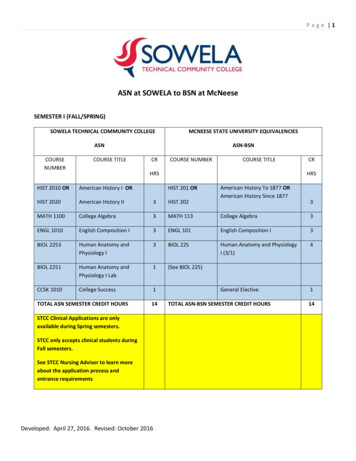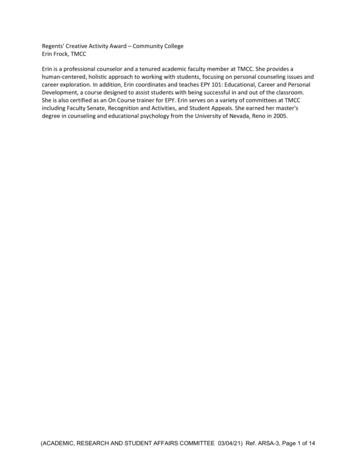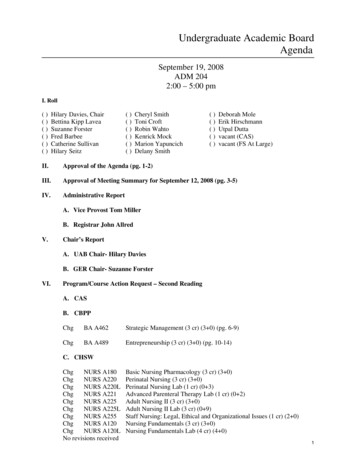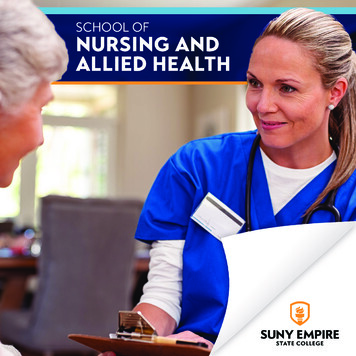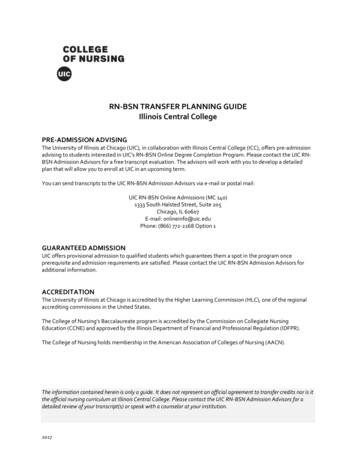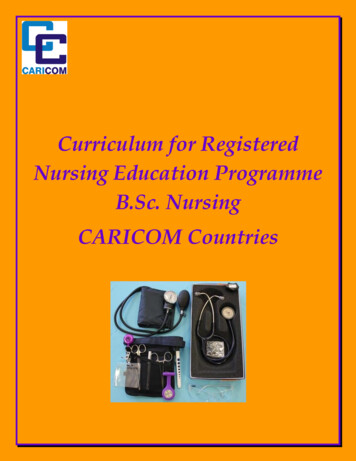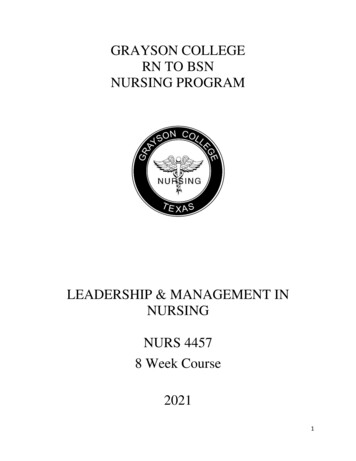
Transcription
GRAYSON COLLEGERN TO BSNNURSING PROGRAMLEADERSHIP & MANAGEMENT INNURSINGNURS 44578 Week Course20211
GRAYSON COLLEGECourse Syllabus for 2020-2021Please Note: Due to extenuating circumstances, including public health issues, course andtesting delivery methods, instructional schedules, housing contracts, campus proceduresand/or operating hours may be altered, interrupted and/or ceased for a limited or extendedperiod of time. Such changes will be posted on the College website.Course Information:NURS 4457, Leadership & Management, Fall 2020Professor Contact InformationName Dr. Michael AndersLocation HS 105, Health Science Building on the Faculty CorridorOffice hours are posted outside office door.Office: 903-463-8683Email: andersm@grayson.eduCourse Pre-requisites, Co-requisites, and/or Other RestrictionsMust have a current, unencumbered RN nursing license in your state of residence.Course Placement: Any time during the RN to BSN Program. Acceptance into the RN to BSNProgram required.Course Description:(4-0-4) This course focuses on exploration of organizational strategies, leadership theories, andsocietal trends with implications for decision-making in healthcare. Management techniques andnursing care decisions are examined by synthesizing knowledge of various health careorganizations.2
End of Program Student Learning Outcomes1.0Member of the Profession:1.1Demonstrate responsibility and accountability in the quality of care for patients, families,populations and communities.1.2Promote the profession of nursing through advocacy and leadership activities.2.0Provider of Patient-Centered Care2.1Incorporate theoretical knowledge and evidence-based research findings in thecoordination of care for patients, families, populations, and communities.2.2Synthesize knowledge from comprehensive health assessment data and evidence-basedresearch to provide care for culturally, ethnically, and socially diverse patients, families,populations, and communities2.3Develop, implement, and evaluate teaching plans for patients, families, populations, andcommunities to address health maintenance, health promotion, and risk reduction2.4Utilize clinical reasoning, knowledge, evidence-based practice, theoretical foundations,and research findings as basis for decision-making and comprehensive patient care3.0Patient Safety Advocate3.1Develop goals and outcomes utilizing theoretical knowledge and analysis, research, andevidence-based data to reduce patient and community risks3.2Develop and implement measure to promote a quality and safe environment for patients,self, families, communities, and populations4.0Member of the Healthcare Team4.1Utilize leadership and management principles to assign and/or delegate nursing care toother members of the healthcare team in relationship to patient and organizational need4.2Integrate referral needs, cost considerations, confidentiality, efficiency of care, andcontinuum of care as it relates to patients, families, communities, populations, and thehealthcare organizationCourse OutcomesUpon successful completion of the course, students will have demonstrated the ability to:1. Demonstrate responsibility for ongoing professional development, including exploration ofrole diversification and life-long learning.2. Integrate concepts of current organizational and systems leadership with the culture of thehealthcare organization to coordinate quality patient centered care.3
3. Integrate theory and research knowledge in the formulation, implementation, and evaluation ofnursing leadership/management actions in various practice settings.4. Utilize contemporary practice technologies, information systems, and communication devicesthat support the delivery of safe nursing practice.5. Apply knowledge of the socio-political forces, economic resources, and regulatory processesthat impact health care delivery.6. Work in partnership with the healthcare team to optimize patient outcomes that reflectadvocacy and human caring for diverse populations across the lifespan.7. Synthesize professional skills, knowledge, and attitudes when applying the nursing process toprovide safe, holistic, evidence-based, patient-centered care.8. Demonstrate values based on historical, moral, ethical, and legal aspects of professionalnursing practice responding to global health needs.Required Textbooks and MaterialsNURS 4301, Leadership & ManagementFall 2020 Required Textbooks and MaterialsBooks can be purchased in print or electronic formISBNAuthorTitle978-0134153117Sullivan, E. J.Effective Leadership and Managementin Nursing (9th edition)978-1433832161Publication Manual of the AmericanPsychological Association, 7th additionRequired Assignments & Academic Calendar(Topics, Reading Assignments, Due Dates, Exam Dates and where/how exams will be administered)In case of inclement weather, emergency closings, or other unforeseen disruptions toscheduled classes, student must log onto their Canvas accounts for directions on where orhow to continue their coursework.4
Course ScheduleSemesterDatesWeek 1 –Class StartsJanuary 11Individual LearningActivitiesDUEPercent ofGradeDiscussion Introduction1/17/21Required, but notgradedSelf-Assessment1/17/215 pointsDiscussion 1 – Who ControlsNursing1/17/212 pointDiscussion 2 – Quality DataReview1/24/212 point*Organizational Analysis:Strategy Plan1/24/215 points*Create PortfolioDiscussion 3 – Conflict in theWorkplace1/24/211/31/212 points2 points*Organizational Analysis: TheOrganization1/31/2110 pointsREAD:Chapter 13-16, EffectiveLeadership and Management inNursing-SullivanDiscussion 4 – SituationExamples2/7/212 point*Budgeting & Staffing Project2/7/2115 pointsWeek 5February 8February14READ:Chapter 17-20, EffectiveLeadership and Management inNursing-SullivanDiscussion 5 – Tasks &Functions in the WorkEnvironment2/14/212 points*Organizational Analysis – TheNurse Leader2/14/2110 pointsWeek 6February15February21Week 7February22February28Weeks 8 –READ:Chapter 21-27, EffectiveLeadership and Management inNursing-Sullivan*Change Theory Project2/21/2115 points*Portfolio Organization2/21/213 pointsREAD:Chapter 28, EffectiveLeadership and Management inNursing-Sullivan*Professional DevelopmentPlan2/28/2110 points*Organizational Analysis –Your Experience2/28/2110 pointsFinal WeekReflective Journal3/3/215 pointsWeek 2January 18January 24Week 3January 25January 31Week 4February 1February 7WELCOME & INTRODUCTIONTO LEADERSHIP ANDMANAGEMENTRead:SyllabusAssignmentsChapter 1-4, EffectiveLeadership and Management inNursing-SullivanREAD:Chapter 5-8, EffectiveLeadership and Management inNursing-SullivanREAD:Chapter 9-12, EffectiveLeadership and Management inNursing-Sullivan5
SemesterDatesMarch 1March 4Individual LearningActivitiesAssignmentsDUEPercent ofGradeComplete Course Projects andWritten AssignmentsAll Assignments DueWednesday at Midnight*These assignments is required for the completion of the course and must be added to the student’sPortfolio as a requirement for completion of the BSN program.Methods of Evaluation(Grading policy including percentages for assignments, grade scale, etc.)Graded activities and percent of the overall course grade:Graded ActivityPercent ofCourse GradeSelf-Assessment5%Reflective Journal/Activities Log5%Discussion Boards5%Budgeting and Staffing Project15%Change Theories Project25%Professional Development Plan10%Organizational Analysis35%Total100%Course Grading PolicyThe grading policy for the RN to BSN program follows that of the college for the letter gradingsystem and grade point determination. This policy is found in the Grayson College Catalog. RNto BSN course grades are assigned as follows:Letter GradeInterpretationNumerical GradeGrade Points/Semester HourAExcellent89.50-1004BGood79.50-89.4936
ing64.49 and below0According to college policy a letter grade of “D” is considered unsatisfactory in a student’smajor field of study and generally does not transfer. Therefore, a grade of “C” or better isnecessary in all RN to BSN courses for satisfactory completion of each level and progression tothe next nursing course.ASSIGNMENT DESCRIPTIONS*Please note: Rubrics for all assessments are located at the end of this syllabus.Methods of InstructionIn accordance with current restrictions related to the COVID 19 outbreak this course willconducted 100% online. There will be no required on-campus activity. This is a 3.0 credit hourcourse Recorded lecturesAssigned textbooks and article readingsExamsCase StudiesConcept MapStudents are expected to be “active learners.” It is a basic assumption of the instructor thatstudents will be involved (beyond the materials and lectures presented in the course) indiscovering, processing, and applying the course information using peer-reviewed journalarticles, researching additional information and examples on the Internet, and discussingcourse material and clinical experiences with their peers.Computer Hardware and Software RequirementsIt is the student’s responsibility to have access to a computer with a reliable Internet connectionand a computer that is compliant with recommended browsers and settings in order to effectivelyutilize Canvas. In order for Canvas to function properly, your computer must have the latestupdates and plugins. Refer to the student handbook or the course module on RequiredTechnology and Skills for details on computer requirements.*Accepted files for submission in Canvas: Please be sure to turn your files, such as researchpapers, in as a Word document (.docx) in Canvas or your submission will not be accepted.(Be sure to choose that file when you set up your assignments or go to edit on existing ones todesignate which files you will accept. That way they can't upload the wrong file).7
*When references are required for assignments, please use references no older than the past 10years unless it is a historical document or if your professor instructs otherwise.AttendanceThe RN to BSN program adheres to the Grayson College Student Handbook attendance policy.Should absences occur which do not allow for full evaluation of student performance (qualityand consistency) faculty will be unable to assign a passing grade. In addition, the followingpolicies are specific to the theory course.1. Regular attendance is expected for all classes.2. Attendance is verified within Canvas for all courses.3. Students must notify the faculty in case of an absence during test times at least one hourprior to the scheduled test time.STUDENT RESPONSIBILITY & ATTENDANCEAttendance online is strongly encouraged. You will miss a deeper understanding of the materialsif you are not participating. There are readings that you will have to complete to be able toadequately participate in individual and group assignments. In order to complete this coursesuccessfully, you do have to participate in all course activities i.e. homework, discussion board,course projects, self–reflections, etc. Students are expected to engage in course activities andsubmit work by due dates and times. The hope is that students will make substantivecontributions that reflect integration of assigned materials as well as any outside readings asappropriate. Scholarly contribution is an expectation. For planning purposes, this class willprobably require a minimum of 6-9 study hours per week on average.COMMUNICATIONFaculty will respond to email and/or telephone messages within 24 hours during working hoursMonday through Friday. Weekend messages will not be returned until Monday.Written communication via Canvas: It is an expectation of this class that you use formal writingskills giving appropriate credit to the source for your ideas. Follow APA (2010) 6th edition (2ndPrinting or higher only) guidelines for referencing.Written communication via email: All private communication will be done exclusively throughyour Viking email address. Check frequently for announcements and policy changes.Virtual communication: Office hours and/or advising may be done with the assistance of thetelephone, online platform, etc.Use Good "Netiquette": Check the discussion frequently and respond appropriately and on subject. Focus on one subject per message and use pertinent subject titles.8
Capitalize words only to highlight a point or for titles. Otherwise, capitalizing is generallyviewed as SHOUTING! Be professional and careful with your interaction. Proper address for faculty is by formal titlesuch as Dr. or Ms. /Mr. Jones unless invited by faculty to use a less formal approach. Cite all quotes, references, and sources. When posting a long message, it is generally considered courteous to warn readers at thebeginning of the message that it is a lengthy post. It is extremely rude to forward someone else's messages without their permission. It is fine to use humor, but use it carefully. The absence of face-to-face cues can cause humor tobe misinterpreted as criticism or flaming (angry, antagonistic criticism). Feel free to useemoticons such as J or :) to let others know you are being humorous.(The "netiquette" guidelines were adapted from Arlene H. Rinald's article, The Net UserGuidelines and Netiquette, Florida Atlantic University, 1994, available from Netcom)ASSIGNMENT SUBMISSION AND FEEDBACKIn this class, all assignments need to be submitted through the Assignments link in the Canvascourse site. This is for grading purposes. Issues with technology use arise from time to time. If atechnology issue does occur regarding an assignment submission, email me atandersm@grayson.edu and attach a copy of what you are trying to submit. This lets your facultyknow you completed the assignment on time and are just having problems with the onlinesubmission feature in Canvas. Once the problem is resolved, submit your assignment through theappropriate link. This process will document the problem and establish a timeline. Be sure tokeep a backup of all work and save your work frequently!I will make every effort to provide feedback and grade submissions within one week of the duedate. If your assignment is submitted late, the feedback timeframe does not apply. I will get to itas soon as possible, but it may take longer than one week.LATE WORK OR MISSED ASSESSMENTS POLICYThe course is set up on weekly modules. The week begins on Monday and ends on Sunday. TheFinal week (week 8) ends on Thursday. Assignment due dates are shown on thecalendar/schedule or posted within Canvas. Five percentage points per day will be deductedfor assignments submitted late. Late assignments will not be accepted after five days.Student Conduct & DisciplineRefer to the RN to BSN Student Handbook for policiesAcademic IntegrityRefer to the RN to BSN Student Handbook for specific policies9
The faculty expects from its students a high level of responsibility and academic honesty.Because the value of an academic degree depends upon the absolute integrity of the work doneby the student for that degree, it is imperative that a student demonstrate a high standard ofindividual honor in his or her scholastic work.Scholastic dishonesty includes but is not limited to cheating, plagiarism, collusion, and thesubmission for credit of any work or materials that are attributable in whole or in part to anotherperson, taking an examination for another person, any act designed to give unfair advantage to astudent or the attempt to commit such acts. Plagiarism, especially from the web, from portionsof papers for other classes, and from any other source is unacceptable and will be dealt withunder the college’s policy on plagiarism (see GC Student Handbook for details). GraysonCollege subscribes to turnitin.com, which allows faculty to search the web and identifyplagiarized material.Plagiarism is a form of scholastic dishonesty involving the theft of or fraudulent representationof someone else’s ideas or words as the student’s original work. Plagiarism can beintentional/deliberate or unintentional/accidental. Unintentional/Accidental plagiarism mayinclude minor instances where an attempt to acknowledge the source exists but is incorrect orinsufficient. Deliberate/Intentional plagiarism violates a student’s academic integrity and existsin the following forms: Turning in someone else’s work as the student’s own (such as buying a paper andsubmitting it, exchanging papers or collaborating on a paper with someone else withoutpermission, or paying someone else to write or translate a paper) Recycling in whole or in part previously submitted or published work or concurrentlysubmitting the same written work where the expectation for current original work exists,including agreeing to write or sell one’s own work to someone else Quoting or copy/pasting phrases of three words or more from someone else withoutcitation, Paraphrasing ideas without citation or paraphrasing incompletely, with orwithout correct citation, where the material too closely matches the wording or structureof the original Submitting an assignment with a majority of quoted or paraphrased material from othersources Copying images or media and inserting them into a presentation or video without citation, Using copyrighted soundtracks or video and inserting them into a presentation or videowithout citation Giving incorrect or nonexistent source information or inventing source information Performing a copyrighted piece of music in a public setting without permission Composing music based heavily on someone else’s musical composition.1st offense: will result in disciplinary action by the Professor (may result in course failure). Acounseling record will be completed and placed in student’s file.2nd offense: will result in disciplinary action by the RN-BSN Faculty Committee (may result in dismissalfrom the program).10
Student ResponsibilityYou have already made the decision to go to college; now the follow-up decisions on whether tocommit to doing the work could very well determine whether you end up working at a goodpaying job in a field you enjoy or working at minimum wage for the rest of your life. Educationinvolves a partnership that requires both students and instructors to do their parts. By enteringinto this partnership, you have a responsibility to show up for class, do the assignments andreading, be engaged and pay attention in class, follow directions, and put your best effort into it.You will get out of your experience here exactly what you put into it – nothing more and nothingless.TITLE IXGC policy prohibits discrimination on the basis of age, ancestry, color, disability,gender identity, genetic information, national origin, race, religion, retaliation, seriousmedical condition, sex, sexual orientation, spousal affiliation and protected veteransstatus.Furthermore, Title IX prohibits sex discrimination to include sexual misconduct: sexualviolence (sexual assault, rape), sexual harassment and retaliation.For more information on Title IX, please contact: Dr. Molly M. Harris, Title IX Coordinator (903)463-8714Ms. Logan Maxwell, Title IX Deputy Coordinator - South Campus (903) 415-2646Mr. Mike McBrayer, Title IX Deputy Coordinator - Main Campus (903) 463-8753Website: itle-ix-policies.htmlGC Police Department: (903) 463-8777- Main Campus) (903-415-2501 - SouthCampus) GC Counseling Center: (903) 463-8730 For Any On-campus Emergencies: 911Grayson College is not responsible for illness/injury that occurs during the normal courseof classroom/lab/clinical experiences.NRSG 4457 Leadership & ManagementDiscussion Forum RubricCriteriaOn TopicExemplaryPerspective on theSatisfactoryPerspective on theUndevelopedPost does not address11
30%Participation30%Evidence ofreferences30%Grammar & APA10%problem/question isclearly identified inan introductorysentence. Allcomments aredirectly related andon topic. (30)Initial post and atleast 2 additionalresponses/commentsare submitted on timeby the student. (30)Post reflects a goodunderstanding of theideas presented andreferences (at leasttwo) are from thetextbook or peerreviewed journals.(30)No spelling,grammar, APAerrors. (10)problem/question isstated somewhere inthe post. Mostcomments are relatedto theproblem/question thatis posed. (20)Initial post ORresponses/commentssubmitted on time bythe student. (15)the problem/questionthat is posed. (10)Post reflects someideas from thereadings. Author isunable to articulatethoughts and ideas.Less than 2references used or notfrom assignedreadings or peerreviewed journals.(20)Few spelling,grammar, APAerrors. (7.5)Post does not reflector reference ideasfrom class materials.(10)No discussion post orresponses/commentsposted by the student.(0)Multiple spellinggrammar, APAerrors. (5)NURS 4457 LEADERSHIP AND MANAGEMENT IN NURSINGPROFESSIONAL DEVELOPMENT PLAN aryThe ProfessionalGrowth Plan indicatesthe student hasthoughtfully identifiedtwo goals that aresignificant in terms ofoverall impact on thenursing profession.The activities/actionsproposed by thestudent in theProfessional GrowthPlan are measureableand the intern offersinsight into how he/sheSatisfactoryUndevelopedThe ProfessionalGrowth Plan is clearlywritten and identifiestwo specific goals forimprovement.The ProfessionalGrowth Plan is vagueand/or does not clearlyidentify two specificgoals for improvement.The activities/actionsproposed by the internin the ProfessionalGrowth Plan aremeasureable and seemrealistic for the scopeof the nursingThe activities/actionsproposed by thestudent in theProfessional GrowthPlan will be difficult tomeasure, they arevague.12
Expected Outcomes20%Resources Needed20%Timelinewill monitor his ownprogress toward goalachievement.AndThe actions/activitiesoutlined by the internseem to bethoughtfully selectedand offer a realistictimeframe for makingimprovements.Concrete ideas arepresented by thestudent.The student is able toidentify at least 1-2expected outcomes foreach of the two goalshe/she has identified.The outcomes areclear, measureable andthe student is able toarticulate in the planwhat evidence willconstitute goalachievement and howthese improvementswill positively impactthe nursing profession.The student’s planincludes 1-2 resourcesneeded for achievingthe two goals.And:The resourcesidentified by thestudent for achievingthe identified goals arethoughtfully realisticand provide options foraccessing neededsupports. The studentrecognizes his/her ownneed to be resourcefuland responsible inaccessing additionalsupports.The student providesprofession.OrThe activities/actionsproposed seem eithertoo broad or toonarrow in scope.The student is able toidentify at least 1-2expected outcomes foreach of the two goalshe/she has identified inthe plan. Theoutcomes are clear,measureable and, ifachieved, willseemingly have apositive impact on thenursing profession.The student’s plan isvague in identifyingwhat he/she hopes toaccomplish whenworking on each of thetwo stated goals.Outcomes aresubjective and difficultto measure.The student’s planincludes 1-2 resourcesneeded for achievingthe two goals.And:The resourcesidentified by thestudent for achievingthe identified goals arerealistic given thestudent’s role andfunction.The student’s plandoes not includeresources for achievingthe goalOr:The resourcesidentified by thestudent for achievingthe identified goals areimpractical orunrealistic.The student provides aThe student provides13
10%500 WordExplanation/Rationale20%both a realistic timelinefor implementing theactivities/actionssuggested in the planand there is a clearexpectation of wherethe student hopes tobe for each goal bygraduation.The student’s 500 wordexplanation is clear andcompellingAnd:The rationale providedillustrates a deeperlevel of insight inconnecting howachievement of thetwo goals will facilitatethe student’s growth asa professional nurse.realistic timeline forimplementing theactivities/actionssuggested in the planand there is only avague expectation ofwhere the studenthopes to be for eachgoal by graduation.The student’s 500 wordexplanation isadequateAnd:The rationale provideddoes link the two goalsto professional nursing.no timeline forimplementing theactivities/actionssuggested in the planand there is nomention of what thestudent hopes toachieve by graduation.The student’sexplanation does notaccompany the planORThe rationale provideddoes not effectivelylink the two goals toprofessional nursing.NURS 4457 LEADERSHIP AND MANAGEMENT IN NURSINGBUDGETING AND STAFFING PROJECT RUBRICCriterionIdentification of MainIssues/Problems20%Analysis and Evaluationof Issues/Problems20%Recommendations onEffective lopedIdentifies anddemonstrates asophisticatedunderstanding of themain issues/problemsin the case study.Presents an insightfuland thorough analysisof all identifiedissues/problems.Supports diagnosis andopinions with strongarguments and welldocumented evidence;presents a balancedand critical view;interpretation is bothreasonable andobjective.Identifies anddemonstrates anaccomplishedunderstanding of mostof the issues/problems.Identifies anddemonstratesacceptableunderstanding of someof the issues/problemsin the case study.Presents a superficialor incomplete analysisof some of theidentified issues.Little or no actionsuggested and/orinappropriate solutionsproposed to the issuesin the case study.Presents a thoroughanalysis of most of theissues identified.Supports diagnosis andopinions with limitedreasoning andevidence; presents asomewhat one-sidedargument;demonstrates littleengagement with ideaspresented.14
Links to CourseReadings andAdditional Research20%Makes appropriate andpowerful connectionsbetween identifiedissues/ problems andthe strategic conceptsstudied; supplementscase study withrelevant andthoughtful researchand documents allsources of information.Writing Mechanics andFormatting10%Demonstrates clarity,conciseness andcorrectness; formattingis appropriate andwriting is free ofgrammar and spellingerrors.Makes appropriate butsomewhat vagueconnections betweenidentifiedissues/problems andconcepts studied;demonstrates limitedcommand of theanalytical tools studied;supplements casestudy with limitedresearch.Occasional grammar orspelling errors, but stilla clear presentation ofideas; lacksorganization.Makes inappropriate orlittle connectionbetween issuesidentified and theconcepts studied;supplements casestudy, if at all, withincomplete researchand documentation.Writing is unfocused,rambling, or containsserious errors; poorlyorganized and does notfollow specifiedguidelines.NURS 4457 LEADERSHIP AND MANAGEMENT IN NURSINGCHANGE THEORY PROJECT ns30%ExemplaryObservations of andcomments about theleader’s effectivenessor ineffectivenesswith change theory.Rationale (research,examples, specificoutcomes) forconnections tospecific styles.Clear description ofyour initial changetheory research andhow that applies inhealth care.Specific statementsdemonstratingpersonal andprofessionalreflection on changeSatisfactoryGeneral observationsof and commentsabout the leader’seffectiveness orineffectiveness withchange theory.UndevelopedMinimal observationsof and commentsabout the leader’seffectiveness orineffectiveness withchange theory.General rationale forsome connections.Little or no rationalefor statementsprovided.General descriptionof your initial changetheory research andhow that applies inhealth care.Vague or missingdescription of yourinitial change theoryresearch and how thatapplies in health care.Generalizedstatementsdemonstratingpersonal andprofessionalUnclear or missingstatementsdemonstratingpersonal andprofessional15
Grammar & APA10%theory. Includingdetailed descriptionof skills you wouldneed and whether ornot you have themnow, and evidence tosupport yourassessment.reflection on changetheory. Includingdetailed descriptionof skills you wouldneed and whether ornot you have themnow, and evidence tosupport yourassessment.reflection on changetheory. Includingdetailed descriptionof skills you wouldneed and whether ornot you have themnow, and evidence tosupport yourassessment.APA format and styleare correct and clear.Areas of focusinclude syntax,appearance,organization, andgrammaticalcorrectness.References andliterature citations arecorrect.APA format and styleare mostly correct.Areas of focusinclude syntax,appearance,organization, andgrammaticalcorrectness.References andliterature citations arecorrect.APA format and styleare minimallycorrect. Areas offocus include syntax,appearance,organization, andgrammaticalcorrectness.References andliterature are cited butcontain mistakes.NURS 4457 LEADERSHIP AND MANAGEMENT IN NURSINGORGANIZATIONAL ANALYSIS- STRATEGY PLAN RUBRICCriterionLearning Plan30%Learning Discussion30%Student Activity30%ExemplaryPerspective LearningPlan follows a logicalstrategy, whichwould maximize thestudents learningopportunity.SatisfactoryPerspective LearningPlan somewhatfollows a logicalstrategy, whichwould help thestudents learningopportunityMultiple learningFew learningmodalities andmodalities andlearning opportunities learning opportunitiesare discussed inare discussed indetail. At least 3 - 4detail. 1-2 specificspecific examples ofexamples of ed discussionMinimal discussionon student activityon student activitythat would promote a that would promote aUndevelopedPerspective LearningPlan follows aminimal or nostrategyNo learningmodalities andlearning opportunitiesare discussed indetail. No specificexamples of learningopportunities.No discussion onstudent activity thatwould promote a16
Grammar & APA10%learning opportunity.Includes a summaryof how the studentplans to meet thepracticum hours.APA format and styleare correct and clear.Areas of focusinclude syntax,appearance,organization, andgrammaticalcorrectness.References andliterature citations arecorr
Jan 17, 2021 · nursing practice responding to global health needs. Required Textbooks and Materials NURS 4301, Leadership & Management Fall 2020 Required Textbooks and Materials Books can be purchased in print or electronic form ISBN Author Title 978-0134153117 Sullivan, E. J. Effective Leadership and Mana

